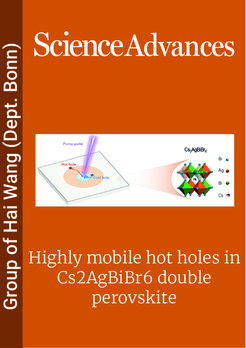Highly mobile hot holes in Cs2AgBiBr6 double perovskite
In a study published in “Science Advances”, employing THz spectroscopy Zhang et al. report excess energy-dependent highly mobile hot holes in Cs2AgBiBr6 double perovskites. The finding could be relevant for utilizing Cs2AgBiBr6 for hot carrier-based optoelectronic devices.

Optical excitation of semiconductors by photons with energy exceeding their bandgap creates energetic, “hot" carriers. In most conventional semiconductors, these hot carriers rapidly dissipate their excess energy to the crystal lattice, becoming “cold" carriers at the band-edge within a few picoseconds (ps, = 10-12 s). This ultrafast energy loss during hot carrier cooling represents one of the major loss channels for solar cells, limiting the solar-to-electricity power conversion efficiency (PCE) to ~ 33% (so-called Shockley-Queisser limit). Harvesting hot carriers before their relaxation is a much sought-after goal for achieving efficient optoelectronics, particularly photovoltaics. One of the main challenges for collecting these hot carriers is the relatively short transport length which arises from the typically short hot carrier lifetimes and significantly reduced hot carrier mobilities in conventional semiconductors (e.g., Si, GaAs). As one of the most promising photovoltaic materials, metal halide perovskites (MHPs) with extremely high PCE possess great potential for hot-carrier optoelectronics. However, the transport properties (e.g., charge carrier mobility) of hot carriers in MHPs have remained elusive and requires further in-depth understanding.

Researchers from Max Planck Institute for Polymer Research, in collaboration with Leuven University, now report their discovery of extremely mobile hot carriers in Cs2AgBiBr6: an environmentally-friendly MHP material, which has been widely explored for application in optoelectronics, e.g., for X-ray detection. Following photo-excitation, the researchers observed an excess energy-dependent boosted hot carrier mobility, reaching a 4-fold enhancement compared to cold carriers at an excess energy of ~1.5 eV. Moreover, the enhanced mobility results in a long-range hot carrier transport length that is comparable to the grain sizes (~200 nm). This observation is in contrast with the hot carrier transport in conventional semiconductors where hot carriers have lower mobility than cold carriers due to the enhanced carrier-optical phonon scattering. By optical pump-IR push-THz probe spectroscopy and frequency-resolved photoconductivity measurements, they provide experimental evidence that the mobility enhancement originates primarily from hot holes which experience reduced momentum scattering compared to the cold carriers. These findings render Cs2AgBiBr6 a fascinating platform for studying the fundamentals of hot carrier transport and realizing efficient hot carrier-based optoelectronic devices. The results are published in the journal “Science Advances".













